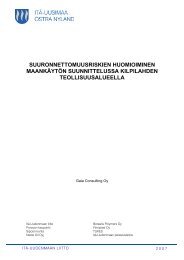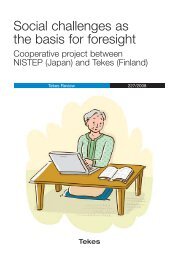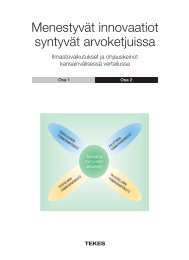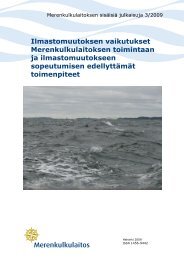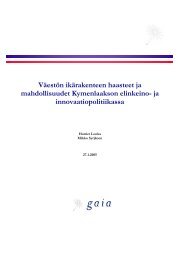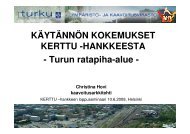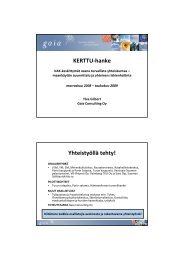Climate Risk Management in Finnish Development Cooperation - Gaia
Climate Risk Management in Finnish Development Cooperation - Gaia
Climate Risk Management in Finnish Development Cooperation - Gaia
Create successful ePaper yourself
Turn your PDF publications into a flip-book with our unique Google optimized e-Paper software.
<strong>Climate</strong> risks for project outcomes<br />
F<strong>in</strong>nWASH BG project approach and content (<strong>in</strong>clud<strong>in</strong>g <strong>in</strong>stitutional, environmental and technical<br />
sett<strong>in</strong>g) are very similar to RWSEP, which was studied above. Tak<strong>in</strong>g note of the start of actual<br />
F<strong>in</strong>nWASH implementation phase <strong>in</strong> July 2009, this <strong>in</strong>itial screen<strong>in</strong>g reviews expected project<br />
outcomes and strongly refers to analysis and f<strong>in</strong>d<strong>in</strong>gs of the RWSEP climate screen<strong>in</strong>g exercise.<br />
The success of <strong>in</strong>stitutional development efforts <strong>in</strong> organiz<strong>in</strong>g water supply facilities will be decisive<br />
for the achievement of F<strong>in</strong>nWASH project objectives. The provision of clean water <strong>in</strong> 5 woredas, for<br />
250 000 people <strong>in</strong> approximately 600 communities will require a.o. the establishment of some 600-<br />
700 water po<strong>in</strong>ts, which are essential for deliver<strong>in</strong>g the expected services. 58 While climate change<br />
and variability may have direct effects on the foreseen project <strong>in</strong>frastructure and implementation, it<br />
may also pose some <strong>in</strong>direct risks related to social, human and <strong>in</strong>stitutional capacities necessary to<br />
achieve the project outcomes.<br />
<strong>Climate</strong>-<strong>in</strong>duced direct risks for F<strong>in</strong>nWASH project outcomes could be related with extreme weather<br />
events, such as droughts, floods and heavy ra<strong>in</strong>s. However, so far droughts and floods have not been<br />
frequently reported <strong>in</strong> the programme woredas. While the programme area generally enjoys an<br />
annual average ra<strong>in</strong>fall amount <strong>in</strong> the range of +-1,000 mm the <strong>in</strong>creased variability <strong>in</strong> ra<strong>in</strong>fall<br />
patterns (changed arrival of ra<strong>in</strong>s, <strong>in</strong>tensiveness of ra<strong>in</strong>s etc) do already pose <strong>in</strong>creased challenges<br />
for local livelihoods and food security.<br />
In the longer-term, cont<strong>in</strong>ued temperature <strong>in</strong>crease (by mid century projected to <strong>in</strong>crease between<br />
1°C and 3°C) could among other th<strong>in</strong>gs pose risks to groundwater level, i.e. water scarcity risks at<br />
some water po<strong>in</strong>ts. With regards to other potential climate parameters (e.g. heat waves, cold<br />
days/nights, storms, wild fires, etc), reportedly these do currently not pose any significant risks at<br />
the project area.<br />
In addition to these risks on the technical water supply system, project implementation could <strong>in</strong><br />
some cases be <strong>in</strong>directly hampered by climate factors, e.g. due to limited access to project areas<br />
caused by heavy ra<strong>in</strong>s or floods. Construction conditions of planned water <strong>in</strong>frastructure could be<br />
worsened for the same reasons but these risks can be managed through sensible tim<strong>in</strong>g of project<br />
activities.<br />
Prior climate considerations<br />
Dur<strong>in</strong>g project preparation, climatic hazards, <strong>in</strong> particular floods and droughts, have been identified<br />
as the most serious external risks that might affect F<strong>in</strong>nWASH BG (<strong>in</strong> addition to overall peace and<br />
stability <strong>in</strong> the region). The likelihood of these climate extremes has been assessed low but potential<br />
impacts significant. These risks have been considered beyond control of the F<strong>in</strong>nWASH programme<br />
58 Some 90% of the water po<strong>in</strong>ts will be hand dug (<strong>in</strong>to a depth of approximately 12-20 meters) and some 10% of the water<br />
po<strong>in</strong>ts will consist of “protected spr<strong>in</strong>gs”.<br />
31



